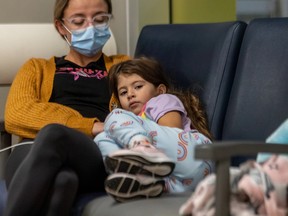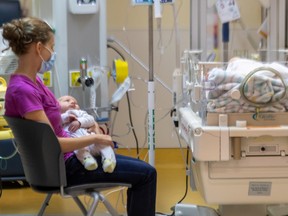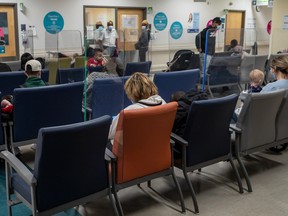 |
Nadal Chacon with her four-year-old daughter Anastasia in the Montreal Children's Hospital emergency waiting room on Friday October 28, 2022. PHOTO BY DAVE SIDAWAY /Montreal Gazette |
Allison Hanes: Situation in Montreal's pediatric ERs is 'like a horror film'
The strain keeps intensifying amid an unprecedented number of sick kids at the Montreal Children's Hospital and CHU Ste-Justine. Can a new crisis cell formed by Quebec's health minister help?
Article content
The sick kids just keep coming.
Article content
Hundreds of them arrive every day in Montreal’s pediatric emergency rooms, and more of them than usual are so ill that they need to be admitted.
Parents camp out overnight, waiting 16, 20, even 24 hours for their children to be seen, depending on the priority they are assigned during triage. Stretchers line hallways. Medical staff are working around the clock to care for more and sicker youngsters.
The relentlessness of this onslaught is something pediatric medicine veterans like Dr. Suzanne Vaillancourt say they have not encountered before.
“It’s definitely the busiest that I can remember in my 20 years of practice at the Montreal Children’s Hospital,” said the ER physician. “We are operating at overcapacity every single day. I feel like we’re experiencing right now what the adult hospitals were experiencing at the peak of COVID. We’re in our viral pandemic, essentially, and we are really working non-stop, overtime, and in really challenging situations.”
Article content
Across Quebec, emergency rooms are under siege as a hobbled health system is taxed by staff shortages, a lack of access to family doctors, an aging population and patients suffering from a range of ailments that may have gone unchecked during the pandemic. But the Montreal Children’s, which is part of the McGill University Health Centre, and the Centre hospitalier universitaire Ste-Justine are beset by a crisis all their own.
Occupancy hit 250 per cent at the Children’s and 300 per cent at Ste-Justine last week. A perfect storm has driven volumes to these unprecedented levels.

One of the culprits is respiratory syncytial virus, or RSV. It may be a new term to the public, but this common infection of the respiratory tract is a familiar ailment doctors know how to treat. What’s unusual is the number of children suffering severe effects, in large part because they haven’t been exposed to many bugs in their young lives.
Article content
“We’re probably seeing about 10 times more patients with RSV than we did before the pandemic,” said Vaillancourt. “When their moms were pregnant, they weren’t out and about like pre-pandemic, so they weren’t exposed and they didn’t pass on the immunity. Even in kids who are one and two years old, who normally don’t get sick with RSV, they haven’t had the immunity. And if you don’t have immunity and you have any other predisposing conditions, like asthma, then you can get a lot sicker.”
While Vaillancourt said most children will recover on their own and simply need “supportive care” at home — like medication to treat fever, rest and lots of liquids — complications can include breathing difficulties and an inability to ingest fluids. These, she said, are serious matters that require emergency intervention.
Article content
But with fewer nurses and orderlies, there are fewer beds for these small patients elsewhere in the hospital. So they remain down in the ER even as new waves of sick children arrive.
“The issue for us, which is really difficult in an emergency room, is we’ll have many, many, many patients waiting to be admitted to the hospital, but we’re still seeing all the other patients that are coming in,” said Vaillancourt. “The physicians and nurses on our team just start to feel overwhelmed because you can only be in so many places at once, and when you’re trying to evaluate multiple sick patients at once, it’s tough. That’s what we’re trained to do, and I think we do it very, very well, but there are limits to our capacity to do that.
Article content
“It’s hard, too, to see parents who have been waiting 16, 20 hours sometimes,” she added. “We’re humans; we empathize with them and what they’re going through.”

It’s the same story at CHU Ste-Justine, where Dr. Antonio D’Angelo, the chief of emergency medicine, said up to 300 patients a day are flooding through the doors.
“In an emergency department, the quality and the security — the safety — of the service is really dependent on the flow-through of the system,” he said. “It really has to work as an efficient machine, and once you get any funnelling effect, where you get a backlog of patients who can’t be admitted to the ward, then the emergency department becomes not only an emergency department, but a ward where you have patients who have to continue to be seen and treated.”
Article content
To cope, nurses are working mandatory overtime and doctors are taking more evening and night shifts. But it’s unsustainable to sprint while running a marathon distance.
“It’s like a horror film where you have one bad thing happen to the protagonist and you think that’s the worst, but around the corner there’s another even worse thing that can happen,” said D’Angelo. “We’re kind of living that situation and it’s very distressing, I would say, because you don’t know what’s around the bend.”
Except D’Angelo has a very good idea of what lurks. If another wave of COVID-19 rises when flu season strikes, the strain will only intensify.
Both doctors are hopeful a new crisis cell announced by Quebec Health Minister Christian Dubé last week may soon provide respite.
Article content
D’Angelo said primary care — family practices, walk-in centres and front-line referral services — need to “step up.” The Quebec government must work to re-establish its cliniques désignées pédiatriques, which ran out of funding last spring. Other hospitals, which in the face of their own surges have given over more beds to adults, have to do their part, D’Angelo said, so pediatric hospitals can care for the increasing numbers of the sickest patients.
Most of the families enduring miserably long waits in his ER simply have nowhere else to go, he lamented.
“There are no alternatives for patients and they’d rather come and wait — even if they have to wait 18 hours on a chair with another child in a stroller, they’d rather wait and see a doctor than not be seen at all,” D’Angelo said. “We even have difficulty sending them home, because they say, ‘Well, what do we do? What do we do after? We don’t have any followup to this. We don’t have a family doctor.’ It’s pretty distressing for everyone.”
source
BECAUSE WE LIKE THE TRUTH








